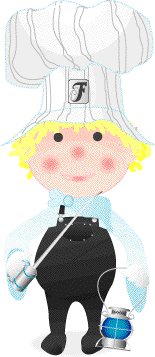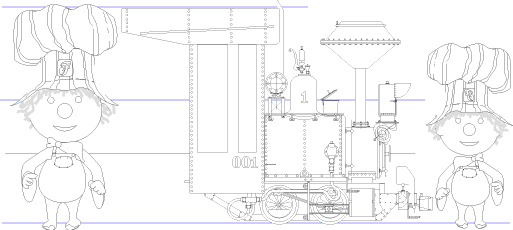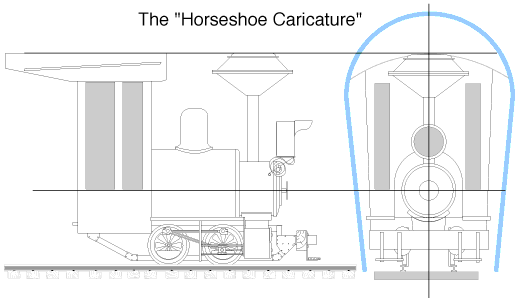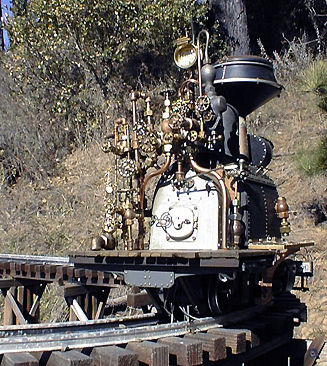





THE DESIGN
Background:
 The Whitby and the IDH RxR, like so many others,
is strongly influenced by the Gorre & Daphitied. Indeed, the
name "Whitby" is a tribute to John Whitby Allen! Unlike
the G&D (or any other railroad that I know of), the IDH is
not a mountain division, but rather a small private industrial
short line operated "entirely above the timberline"!
The appropriate first livery for such an operation would have
to be some form of contractor's engine. As the only livery initially,
it would also have to be a versatile little power plant capable
of performing any number of tasks it might encounter "up-in-the-middle-of-nowhere".
Among these duties would be moving water around and through the
loco's tanks and boiler at will, accessing or distributing water
from and to multiple sources, fire-fighting, and several winch/crane
functions including dragging trees up out of the forest below,
moving boulders from the right-of-way, re-railing itself, or grappling
its way up an unusually steep grade over icy or otherwise slippery
track. At the same time, it must be musical and funny, indeed,
these two things are more important than all that other stuff
up above! The only locomotive works considered (by the elves)
to be capable of creating such an engine was The Whitby Locomotive
Works, and a commission was sent forth immediately (see: The
Official History of The Whitby Locomotive). The photo on the
left is a thumbnail...
The Whitby and the IDH RxR, like so many others,
is strongly influenced by the Gorre & Daphitied. Indeed, the
name "Whitby" is a tribute to John Whitby Allen! Unlike
the G&D (or any other railroad that I know of), the IDH is
not a mountain division, but rather a small private industrial
short line operated "entirely above the timberline"!
The appropriate first livery for such an operation would have
to be some form of contractor's engine. As the only livery initially,
it would also have to be a versatile little power plant capable
of performing any number of tasks it might encounter "up-in-the-middle-of-nowhere".
Among these duties would be moving water around and through the
loco's tanks and boiler at will, accessing or distributing water
from and to multiple sources, fire-fighting, and several winch/crane
functions including dragging trees up out of the forest below,
moving boulders from the right-of-way, re-railing itself, or grappling
its way up an unusually steep grade over icy or otherwise slippery
track. At the same time, it must be musical and funny, indeed,
these two things are more important than all that other stuff
up above! The only locomotive works considered (by the elves)
to be capable of creating such an engine was The Whitby Locomotive
Works, and a commission was sent forth immediately (see: The
Official History of The Whitby Locomotive). The photo on the
left is a thumbnail...
"The little engine that might have!"
The
Whitby locomotive is roughly based on the cute little two foot
and smaller gauge tea kettles used by contractors and extremely
small logging and mining industrial short lines around the turn-of-the-century.
These tiny engines effectively replaced humans, horses, donkeys,
burros and mules in the type of work they did, and were famous
for crawling along poorly laid temporary trackwork (and being
re-railed by hand).
Although the Whitby has the "outline look" of a Porter built, it is a distinct fantasy prototype in several important ways. It has cylinder valves and a center mounted steam dome more like a Baldwin 0-4-0. It also has many appliances, such as a hydrostatic lubricator, found only on much larger livery. The idea here was to capture the look and feel of the earliest and smallest live steam engines in a way that appears historically correct, without actually being historically correct! Additionally, I wanted as many steam systems as possible to reinforce and afford opportunities to the musical instrument character of the intended sound design.
One might suspect that a fantasy prototype would allow for
certain fictions to be taken, for example, with mechanical accuracy.
On the contrary, a great deal of research was necessary in order
to know about everything that ever was, before one could confidently
go about the task of designing a believable "something that
never was"! It was my goal to create an engine that held
up to the most knowledgeable scrutiny, even though I knew that
without an actual prototype no one could legitimately nit-pick
on it. Success in this has been born out by the fact that several
long-time live steamers have been fooled into believing that the
Whitby is a working steam powered model. Of course these "old
heads" had only viewed the Whitby in a static state. The
point here is this, a three dimensional cartoon does not necessarily
mean an abbreviated work. The Whitby is complete in every detail,
and represents much more research work than simply copying a prototype
(which is not simple).
ELF ERGONOMICS:
A "CARICATURE OF SCALES"

Figure 2
A. C. Jones "in the mirror"
This is what an elf sees when he looks in the mirror...
Above is a view of what an elf sees when looking at himself in the mirror. Elves really do exist. And in reality they are invariably less than three feet tall (not including hats). The head of an average elf is somewhat larger than that of an adult human being. This may seem strange to the human eye at first, but remember that it appears quite normal from the elf's point of view (you can experience the elf's alternate reality experience for yourself by looking into a regular mirror, your reflection should appear normal... to you!). To themselves and each other, the elves appear to be the same as always, and so does the world around them.
The elves take all this quite seriously, although it may not seem like it. In fact at first it seemed to me that they were incapable of taking anything seriously at all, but after you get to know them you begin to realize that they are only incapable of "seeming to" take anything seriously. They really do take things seriously no matter how it seems! Take having fun for instance, they are quite serious about that, no matter how much fun they're having! The only point is this... If they seem happy with their world, then if I'm to be a designer for them, I must take all this seriously too.
By Design or by Accident!?
Caricature should never happen by accident or you
can easily end up with the grotesque. Even if grotesque is what
you are going for, it should be on purpose! For example, there's
a reason to place a gargoyle on a structure, and the nature and
the expression of the gargoyle will be defined by that structure.
However, when done right, a caricature should "appear"
to have just happened by accident, you know, naturally! The IDH
is an ongoing experiment in caricature of design. Since the elves
were an extremely clever and adorable pre-existing caricature
of proportion (The Walter Elves, department store Christmas display
animation), it is only natural that their world should reflect
that caricature of proportion.

Elf Ergonomics
This illustrates the relationship of design for
the elves. The elf on the left is shown approximately the same
size as the loco to demonstrate the proportional relationship
between the two, the elf on the right is actual size when compared
to the loco. When compared to a human, an elf is much smaller
at the bottom, and is much larger at the top... so is the world
we design for them! The Whitby Locomotive is shown here, but the
same caricature is applied to buildings, tools, trees, and everything
else in the elves' little world.

Figure 2, The Horseshoe
Caricature
When viewed from the side the Whitby
Locomotive jumps up in scale as you move your eye up from the
trackwork. Viewed from the front (or back) it also graduates to
progressively larger scales as the eye moves outward from the
boiler center-line in any direction (except down). Both caricatures
are in effect and visible from any vantage point, and the overall
impression is one of a locomotive that at once looms up, and out
at you. Dubbed the horseshoe caricature from its appearance when
viewed from the ends, this caricature of scales has the effect
of pulling the viewer into the realm of the elf. It is even more
pronounced in display scale, suspending disbelief for the full
size human. If you are a scale human (a kid type) the effect is
even more pronounced!

The Design of the "Backhead"
This artwork illustrates the
the relationship of "Elf Ergonomics" as applied to an
otherwise normal design. The elves are (and they do not mind me
saying this...) littler at the bottom, and bigger at the top!
The "caricature of scales" in the Gauge One model ranges
from 7/8" at the trackwork, up to 1 1/2" scale as you
move up, and out from the boiler centerline. Most of the steam
valves, steam fittings, and valve handles are actually 1.6"
scale live steam fittings (noticeably missing are the throttle
lever, fire box door, and parts of the steam water pump and steam
generator feed systems).
